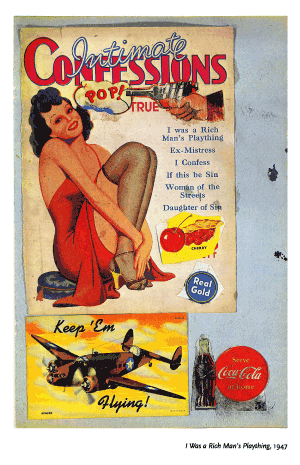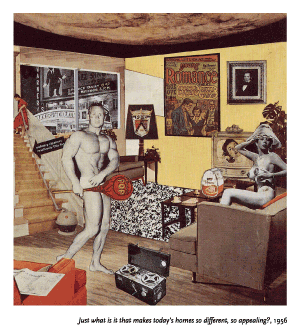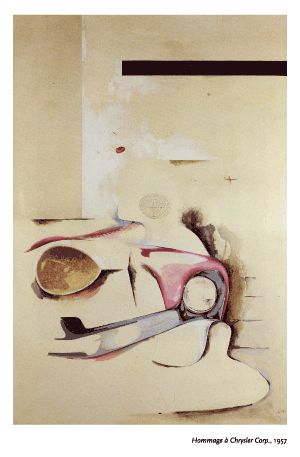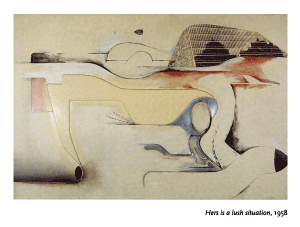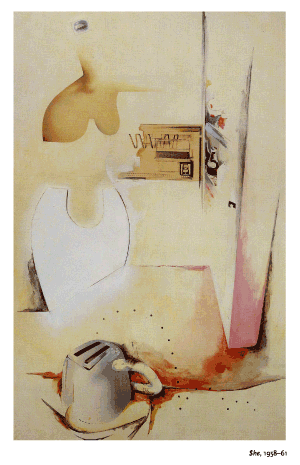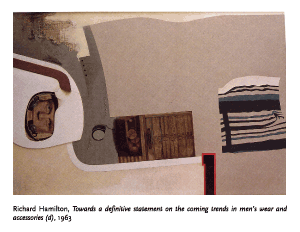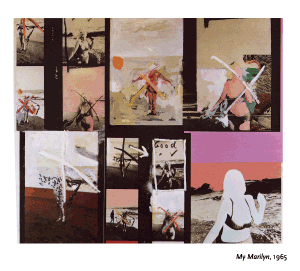An epic poem of early Pop by the architects Alison and Peter Smithson, in an essay published in November 1956, three months after the landmark Independent Group exhibition ‘This is Tomorrow’ opens at the Whitechapel Gallery: ‘Gropius wrote a book on grain silos, Le Corbusier one on aeroplanes, and Charlotte Perriand brought a new object to the office every morning; but today we collect ads.’ Forget that Gropius, Corbusier and Perriand were also media-savvy; the point is polemical: they, the protagonists of modernist design, were cued by functional structures, vehicles, things, but we, the celebrants of Pop culture, look to ‘the throw-away object and the pop-package’ for our models. This is done partly in delight, the Smithsons suggest, and partly in desperation: ‘Today we are being edged out of our traditional role by the new phenomenon of the popular arts—advertising . . . We must somehow get the measure of this intervention if we are to match its powerful and exciting impulses with our own.’footnote1 Others in the IG, Reyner Banham and Richard Hamilton above all, share this urgency.
1
Who are the prophets of this epic shift? The first we to ‘collect ads’ is Eduardo Paolozzi, who calls the collages made from his collection ‘Bunk’ (an ambivalent homage to Henry Ford?). Although this ‘pinboard aesthetic’ is also practised by Nigel Henderson, William Turnbull and John McHale, it is Paolozzi who, one night in April 1952, projects his ads, magazine clippings, postcards and diagrams at the Institute of Contemporary Arts, in a demonstration that underwrites the distinctive method of the IG, an anti-hierarchical juxtaposition of archival images disparate, connected, or both at once. The ‘Bunk’ idea is developed in such shows as ‘Parallel of Life and Art’, directed by Paolozzi, the Smithsons and Henderson in 1953, ‘Man, Machine and Motion’, produced by Hamilton in 1955, and ‘This is Tomorrow’, which grouped artists, architects and designers in twelve teams in 1956; it is also elaborated in such practices as the ‘tabular image’ of Hamilton, as I will discuss.
If Paolozzi suggests an aesthetic paradigm that is at once collagist and curatorial, it is Banham, the great animateur of the IG, who provides the theoretical arguments for a Pop Age. ‘We have already entered the Second Machine Age,’ he writes in Theory and Design in the First Machine Age (1960), ‘and can look back on the First as a period of the past.’footnote2 In this dissertation, conceived in the midst of the IG, Banham exploits his distance, both historical and ideological, from the framers of modern architecture (including his advisor Nikolaus Pevsner) in order to redefine its meaning. He challenges the functionalist and rationalist biases of Gropius and Corbusier, Giedion and Pevsner—that form follow function and technique—and recovers the Expressionist and Futurist imperatives of modern architecture that they neglected. In so doing Banham also advances the imaging of technology as the principal criterion for design—for design of the Second Machine Age, or the First Pop Age, as well.
Might we operate a similar parallax today, and do onto Banham, Hamilton and colleagues what they did onto the modernists? That is, if the IG detected a shift in conditions from the Machine Age, might we trace a similar displacement vis-à-vis the Pop moment? As we frame our questions of Pop—concerning the phenomenology of the screened image, the formation of the subject in a mediated world, the representability of technologies that often appear immaterial—might we also refine our questions about art, architecture and design today? No doubt if we pursue this line of inquiry, related mistakes in self-understanding will be made: if the Pop moment showed the Machine Age to be charmed by an instrumental reason, and we see the Pop moment as taken over by a media euphoria, what might our dominant ideology be revealed to be? Or are we still too suspicious of all such epic poems, all such period fictions, to permit these questions in the first place? (Obviously I am not; I think we default on cultural narratives at great cost—one counted in, among other ways, the slack relativism of much contemporary art and the indifferent thematicism of much exhibition practice.)footnote3
2
If Banham is to be our model of revisionism, we need to know more about his project. First and foremost, he is committed to modern architecture, but again not to the canon of Gropius, Corbusier and Mies laid down by Pevsner, Giedion, Hitchcock and others. Banham challenges this edited version of modernism, however, according to its own criterion of how best to express the Machine Age (he too scorns all historical revivalism, including, later, the postmodern version). According to Banham, Gropius and company imitate only the superficial image of the machine, not its energistic principles: they mistake the simple forms and smooth surfaces of the machine for the dynamic operation of technology. This vision is too ‘selective’; it is also too orderly—a ‘classical’ aesthetic dressed up in the guise of the machine. Corbusier all but confesses this classicism-through-the-machine when he juxtaposes a 1921 Delage sports car with the Parthenon in his Vers une architecture (1923). For Banham this is absurd: cars are Futurist ‘vehicles of desire’, not Platonic type-objects, and only a subject who thrills to the machine as ‘a source of personal fulfilment and gratification’ can embody its spirit.footnote4
In this regard Banham the Pop prophet is not so at odds with Banham the revisionary modernist. Like others in the IG, he is raised on the popular culture of American comics and movies before the war; this is what ‘Pop’ means after the war as well, not folk in the old sense or Pop in the current sense: the former no longer exists for them, the latter does not yet exist for anyone. The IG is near enough to this American culture to know it well, but far away enough to desire it still, especially in an austere Britain short on attractive alternatives (the lofty civilization of Kenneth Clark, the mealy modernism of Herbert Read, the worker folk world of Richard Hoggart). The result is that the IG doesn’t question this culture much: hence the apparent paradox of a group that is pro-Left and pro-American at once. At this time a second, consumerist Americanism supplants the first, Fordist Americanism that swept through Europe in the 1920s—an Americanism of imagistic impact, sexy packaging, speedy turnover. These become the design criteria of the Pop Age for Banham, and they lead him to celebrate the ‘plug-in’ architecture of Cedric Price and Archigram in the 1960s.
His revision of modern architecture is thus not only academic; it is also a way to reclaim an ‘aesthetic of expendability’, first proposed in Futurism, for the Pop Age, where ‘standards hitched to permanency’ are no longer relevant.footnote5 In this experiment Banham has two laboratories: the IG, both its discussions and its exhibitions, and his prolific essays where he applies to commercial products the iconographic methods that he learns for high culture at the Courtauld Institute. More than any other figure, Banham leads design theory away from a modernist concern with abstract forms to a Pop semiotics of cultural images, in a way that follows the shift from the architect as arbiter of machine production to the stylist as instigator of consumerist desire. ‘The foundation stone of the previous intellectual structure of Design Theory has crumbled,’ Banham writes in 1961, ‘there is no longer universal acceptance of Architecture as the universal analogy of design.’footnote6 In this scheme the Book doesn’t kill Architecture; the chrome fender and the plastic gizmo do. In different ways the Smithsons and Price and Archigram take ‘the measure of this intervention’ in architecture; Hamilton does the same in painting.
3
Hamilton shares many of the Pop-Futurist enthusiasms of Banham. He too sees the machine as exemplary by dint not of its functional ‘fitness’ but of its fantasmatic power, its mythic force. In his introduction to ‘Man, Machine and Motion’ of 1955, a gridded display of over 200 images of mechanomorphs under sea, on land, in the sky and in outer space, Hamilton even recycles the old Marinetti trope of a man-machine ‘centaur’ from the first Manifesto of Futurism.footnote7 Yet his archive of images is largely obsolete, his mechanical centaurs are almost campy, and this cannot but render the techno-futurism on offer here somewhat absurd. Never as ‘gonzo’ as Banham, Hamilton practises an ‘ironism of affirmation’ toward Pop culture (he borrows the phrase from his mentor Duchamp) or, in his own words, a ‘peculiar mixture of reverence and cynicism’.footnote8
In ‘This is Tomorrow’ of 1956 Hamilton is grouped with John Voelcker and John McHale, and ‘ironism of affirmation’ is again in play. His team decides that new kinds of ‘imagery and perception’ require new strategies of representation, and Hamilton constructs his little collage, Just what is it that makes today’s homes so different, so appealing?, to the first end—to tabulate the emergent Pop iconography of ‘Man, Woman, Humanity, History, Food, Newspapers, Cinema, TV, Telephone, Comics (picture information), Words (textual information), Tape recording (aural information), Cars, Domestic appliances, Space.’ Although indebted to Paolozzi’s ‘Bunk’, Just what is it? initiates his distinctive version of the Pop image, a space of pumped or primped figures, commodity images and media emblems that, in his own description, is ‘tabular as well as pictorial’.footnote9
Two months later, in a January 1957 letter to the Smithsons, Hamilton sums up IG research to date: ‘technological imagery’ (explored in ‘Man, Machine and Motion’), ‘automobile styling’ (discussed by Banham), ‘ad images’ (credited to Paolozzi, McHale and the Smithsons), ‘Pop attitudes in industrial design’ (exemplified by the House of the Future of the Smithsons), and ‘the Pop Art/Technology background’ (the entire IG, ‘This is Tomorrow’).footnote10 These interests will inform his tabular pictures to come, in particular a suite of three, Hommage à Chrysler Corp. (1957), Hers is a lush situation (1958), and $he (1958–61). I want to review them briefly now—to come to terms with this type of picture and to speculate about some of its implications.
4
Hommage à Chrysler Corp. begins his intrigue with the automobile as core commodity and design-object of the 20th century (that is, until the PC), and for Hamilton it is more metamorphic ‘vehicle of desire’ à la Banham than Platonic type-object à la Corbusier. ‘It adopts its symbols from many fields and contributes to the stylistic language of all consumer goods’, he writes in 1962. ‘It is presented to us by the ad-man in a rounded picture of urban living: a dream world, but the dream is deep and true—the collective desire of a culture translated into an image of fulfilment. Can it be assimilated into the fine art consciousness?’footnote11
Hommage is his first attempt to meet this IG mandate, and here his ironism of affirmation is not paradoxical, for Hamilton is so affirmative of automobile imaging at mid-century, so mimetic of its moves, that he is led to ironize its fetishistic logic: that is, to expose the break-up of each body on display—the new Chrysler in the foreground and the vestigial showgirl behind it—into sexy details whose production is obscure. Not only does Hamilton associate the body parts of each by analogy (the breast, say, with the headlight), but in so doing he demonstrates a conflation of commodity fetishism with sexual fetishism, as the two bodies exchange properties, even parts (à la Marx) in a way that invests them with erotic force (à la Freud). Perhaps this conflation of fetishisms is historically new to this moment: though foreseen in Surrealism, it is only foregrounded in Pop, which acts out this super-fetishism in ways that are excessive but demonstrative.
Signal characteristics of the tabular picture are already apparent in Hommage. First, the composition is, in his own words, ‘a compilation of themes derived from the glossies’—several images for the car, the woman, and the showroom each.footnote12 Fragmented, the body of the car is also rotated for display (this happens to female figures in other pictures like $he, as if the skill of Old Master drawing had become a technique of semi-pornographic surveying). I read the headlight and bumper as the front, the fin and fender as the rear. Fetishistically specific (like Banham, Hamilton is a detail buff: ‘pieces are taken from Chrysler’s Plymouth and Imperial ads; there is some General Motors material and a bit of Pontiac’), these parts are also smoothened into near abstraction: if the woman caresses the car in the painting, so too does Hamilton caress its image in paint. The woman is also reduced to charged parts within a curvaceous outline, to breast and lips, which Freud counted among ‘the secondary sexual characteristics’—here represented by an ‘Exquisite Form Bra’ and the pout of one ‘Volupta’, a star of a late-night American TV show of the time. This is representation as fetishization, an almost campy version of what Benjamin called ‘the sex appeal of the inorganic’.footnote13 Such is the fetishistic chiasmus of this tabulation—a car is (like) a female body, a body is (like) a car—and the two commingle in this chiasmus as if naturally. (This is also borne out by the sexist lingo of the day: ‘nice chassis’, ‘great headlights’, and so on.)
Everything here is already mediated for display: ‘The main motif, the vehicle, breaks down into an anthology of presentation techniques’, Hamilton tells us, and he does highlight in paint the print versions of glossy colour and shiny chrome, all previously screened by the lens, as if there were no other mode of appearance. Space is also thus transformed: it has become display-space tout court, here a showroom based on ‘the International Style represented by a token suggestion of Mondrian and Saarinen’.footnote14 Foucault remarks that with Manet the art museum becomes the frame of painting, and Benjamin that its primary value becomes exhibition value; with Hamilton this frame is more purely one of exhibition—the showroom—and exhibition value is pushed toward consumption value.footnote15
Hamilton also speaks elliptically of ‘a quotation from Marcel Duchamp’, whose Green Box of notes for The Bride Stripped Bare by Her Bachelors, Even (The Large Glass, 1915–23) already obsesses him at the time of Hommage (he publishes his typographic translation of the Green Box in 1960). Perhaps he has in mind another note that speaks of ‘the interrogation of the shop window’ and ‘the coition through the glass pane’.footnote16 If so, this interrogation is now the enticement of the showroom where not only have traditional line, colour and modeling become means of product display, but aspects of modernist art and architecture—‘Mondrian and Saarinen’, diagrammatic signs and geometric bands—have also become devices of commercial exhibition. (This is another distinctive insight of Pop artists like Roy Lichtenstein, who shows us modernism mediated through comics.) Or perhaps the allusion to Duchamp is more general—that, like the Large Glass, this conjunction of Chrysler and showgirl is a kind of Bachelor Machine. But which is the bachelor and which the bride? Unlike Duchamp, Hamilton lets the two meet; the shop window is dissolved, desire is transformed.
5
In his next tabular picture, Hers is a lush situation (1958), Hamilton pushes the association of body parts of car and woman beyond formal analogy to actual commingling: the lines of bumper, headlight, fin, windshield, and wheel become one with the curves of the implicit driver. Another tabulation of images from the glossies, the painting is generated from a line in an Industrial Design review of a recent Buick: ‘The driver sits at the dead calm center of all this motion: hers is a lush situation’.footnote17 Perhaps this is the next stage in his Pop evolution of the Bachelor Machine, one that brings Hamilton into the Bataillean orbit of Hans Bellmer: Hers is a lush situation as a graphic updating of Machine Gunneress in a State of Grace (1937), where Bellmer renders woman and weapon one. But what is still perverse, even obscene in Bellmer has become somehow normative, almost beautiful here: a lush situation, not a surreal threat. Although Hamilton worked to assimilate design into ‘fine art consciousness’, here the flow is in the opposite direction, and it is far along: the genre of the Odalisque is subsumed in an ad for a Buick (all that remains of the nude, as with the Cheshire cat, is her smile); or, better, a De Kooning drawing is not erased by Rauschenberg but reworked by an automobile stylist. In the process, line, which is still individual and expressive in De Kooning, a medium of contact between artist and model (or nature), appears for all its lushness almost engineered and statistical: ‘line’ becomes ‘the right line’ for ‘the new line’ of Buick—a suturing device between ad-man and consumer. And if line is revalued here, so is plasticity, in a way that makes animation and reification difficult to distinguish. This old Futurist dream, which first came true in fascist culture, comes true again, in a different way, in consumerist culture. ‘More than a substance, plastic is the very idea of its infinite transformation’, Barthes writes in Mythologies just a year or two before Hers is a lush situation is painted—‘the whole world can be plasticized, and even life itself . . .’footnote18
6
‘Sex is everywhere,’ Hamilton writes in 1962, ‘symbolized in the glamour of mass-produced luxury—the interplay of fleshy plastic and smooth, fleshier metal’.footnote19 This erotic plasticity is not only fetishistic, a matter of charged details, but also sublimatory, a matter of abstractive displacements—it is as if Hamilton tracks the desirous eye in its saccadic jumps across associated forms. Together these two operations, fetishistic detailing and sublimatory sliding, inform the hybrid space of his tabular pictures—at once specific and sketchy in content, broken and seamless in facture, collagist and painterly in medium.
This combination is also at work in $he (1958–61), his tabular summa, which Hamilton describes as another ‘sieved reflection of the ad-man’s paraphrase of the consumer’s dream’.footnote20 If the magazine image of a Chrysler provides the layout of Hommage, here it is a shot of a Frigidaire—apparently there is no end of the showroom, not even (especially not) at home. Hamilton lists no less than ten sources, all credited to particular designers and brands, for the fridge, the woman, and the hybrid of toaster and vacuum cleaner below: like Banham he is a mad iconographer of Pop representations of everyday life—that is, in this case, of domestic work. Like Hommage, $he exploits the advertising genre of the woman-wife caressing the vehicle-appliance, yet here it is the commodity that seems to offer the human for sale (this is also signalled by the dollar-sign in the title). Once more the woman is reduced to an erotic ‘essence’, not breast and lips as in Hommage, but eye and hips. As in Hers is a lush situation, the hips are in whitened relief, while the eye is a plastic one taped into position: like painting, relief and collage are exploited for fetishistic effect, not the opposite. The eye opens and closes like the fridge, turns on and off like the toaster. Apparently in the Pop world of animated things it is not only sardine cans that look back at us; and far from a threat as in Lacan, this gaze is a winking come-on.footnote21
7
Maybe now I can spell out, however telegraphically, a few implications of the tabular picture. To start with the word (Hamilton is as particular about terms as he is about images), ‘tabular’ derives from tabula, Latin for table, but also for writing-tablet, in which, in ancient use, both painting and printing figure as modes of inscription. Surely this association appeals to Hamilton, who uses both techniques in his own practice in large part because he finds them, already so imbricated, in the media. ‘Tabular’ also invokes writing, which Hamilton involves through his generative lists and descriptive titles; moreover, his pictures register the traces of the visual-verbal hybrid characteristic of the magazine spread or the tabloid layout (perhaps ‘tabular’ connotes ‘tabloid’ as well), a hybrid that anticipates the visual-verbal sign (call it a bit or a bite) that dominates electronic media space today, an often lush image that carries an often insistent directive (‘click here’, ‘buy this’, ‘don’t worry be happy’).footnote22
Again, some of his pictures are tabular in another sense: generated by a table of terms, as with Just what is it?; or of images, as in Hommage and $he; or of journalistic jingles, as in Hers is a lush situation or Towards a definitive statement on the coming trends in men’s wear and accessories (1962–3; the title derives from a Playboy review of male fashion). More directly, ‘to tabulate’ is ‘to set down in a systematic form’, and Hamilton is often concerned, as he says, with an ‘overlapping of presentation styles and methods’: styles and methods that are commercial (as in the various display techniques that he evokes); modernist (as in the various abstract signs that he cites); and modernist-turned-commercial. (The last is most suggestive: Pop receives the ‘reconciliation’ of avant-garde and mass as given.) In his own words, ‘photograph becomes diagram, diagram flows into text’, and all is transformed by painting. At the same time he wants ‘the plastic entities [to] retain their identity as tokens’, and so uses ‘different plastic dialects’, such as photography, relief, collage, ‘within the unified whole’ of painting.footnote23 Like an ad-man, then, Hamilton tabulates—as in correlates—different media and messages, and tabulates—as in calculates—this correlation in terms of visual appeal and psychological effect.
In Pop it is not often clear when this redoubling is analytical and when it is charmed; this is especially so in Hamilton. Yet one thing seems clear enough: his pastiche (which is not a negative term for him) is not disruptively random, as it is, say, in many collages of Berlin Dada. Another insight of Pop—or ‘Son of Dada’ as Hamilton calls it—is that ‘randomizing’ has become a feature of the media, print and otherwise; a logic within the repertoire of the culture industry.footnote24 Sometimes he pushes this logic of the random to a demonstrative extreme. At other times his tabular pictures are logical in another sense, that is, almost typological, as in the suite of images Towards a definitive statement on the coming trends . . . Hamilton describes them as a ‘preliminary investigation into specific concepts of masculinity’, here typified by President Kennedy, a Wall Street broker cum football player, a weightlifter cum track athlete, and astronaut John Glenn, each shown wired to a particular mechanism of sport, entertainment or media—that is, to a spectacle-device.footnote25 Perhaps more than any of his images, these recall the mediated collages of Rauschenberg; yet the tabular picture should not be confused with the ‘flat-bed picture plane’ of his American contemporary (as Leo Steinberg named it in ‘Other Criteria’).footnote26 Both are ‘horizontal’ operations, it is true, maybe in the practical sense of how they are assembled in the studio, sometimes tabulated on the floor, certainly in the cultural sense that they both scan across ‘the fine/pop art continuum’.footnote27 Nevertheless, as Hamilton states as early as Just what is it?, the tabular image is also pictorial: for all its horizontal tabulation of semi-found images, it remains a vertical picture of a semi-illusionistic space—even though this orientation is associated with the magazine layout or the media screen as much as the painting rectangle; Benjamin once called it ‘the dictatorial perpendicular’.footnote28 The tabular picture is also iconographic in a way that Rauschenberg is not (despite the attempts of art historians to track his sources as if he were Hieronymus Bosch); and in keeping with the IG, let alone the design industry, it is also communicative, almost pedagogical—again as Rauschenberg is not. The tabular picture is also more a research model than an ‘anomic archive’ as suggested with regard to Gerhard Richter.footnote29 There is no American or European equivalent that I know.
8
In the age of mechanical reproduction, Benjamin once remarked, ‘literacy’ must include the decoding of captioned photographs.footnote30 Additionally in the Pop age, Hamilton suggests, it must entail a deconstructing of the mediated image-word bite that hails us from magazines, billboards, television, and now computers too. This ‘literacy’ is fundamental to postwar self-fashioning, which has to do far less with any canon of art and literature than with a host of media-apparitions and commodity-signs. (The recent Canon Wars in the academy obscured the fact that the primary canon today consists of television shows, blockbuster movies, sports trivia, celebrity gossip.) Suggestively, the word ‘tabular’ refers not only to graphic inscription; in ancient use it also connotes ‘a body of laws inscribed on a tablet’. Might these tabular pictures be construed as pedagogical investigations of a ‘new body of laws’, a new subjective inscription, a new symbolic order, of Pop society?
Hamilton is self-aware about the preconditions of this new order (if that is what it is). As an artist he is committed to nature, but knows that it is ‘second-hand’: ‘In the 50s we became aware of the possibility of seeing the whole world, at once, through the great visual matrix that surrounds us; a synthetic, “instant” view. Cinema, television, magazines, newspapers immersed the artist in a total environment and this new visual ambience was photographic’. He is also committed to the figure—his Collected Words ends with this statement: ‘I have never made a painting which does not show an intense awareness of the human figure’—but knows that it too is transformed, not only rearticulated by machines and confused with commodities (this is not news) but also now designed-and-redesigned as an image-product.footnote31
Consumer society, Hamilton writes in ‘Persuading Image’, a paper first delivered in 1959, depends on the manufacturing of desire through design, on an artificial, accelerated obsolescence of image, form and style. In the process (which he assumes, not critically but also not moralistically) the consumer is also ‘manufactured’, designed to the product. ‘Is it me?’, he remarks of the commodities in $he, miming the ad-man miming the buyer: ‘the appliance is “designed with you in mind”’.footnote32 It is this condition that his tabular pictures work over: not only the fetishistic conflation of different objects and aims, but also the interpellation of the subject in the image, as an image. Today this process has become internal to the subject, who serves as designer and designed in one, a kind of servomechanism of consummated consumption. When Hamilton turns to his version of the great Pop icon in My Marilyn (1965), he adapts, in painting, a negative sheet from a photo shoot with her own editorial marks: which images to cut (she is merciless), where to crop—in short, how to look, to appear, to be. His Marilyn is still a star, but less as an erotic object than as a model designer, as the master artist of her own powerful iconicity. How different, perhaps more pointed, than the anxiety of a de Kooning or the thraldom of a Warhol.footnote33
9
Just as the product is in excess of function, Hamilton suggests in ‘Persuading Image’, so demand is in excess of need. In effect he sketches a consumerist formula of Demand minus Need equals Desire that is not too distant from the formula of desire that Lacan also develops in the 1950s.footnote34 Lacanians will scorn this speculation, but might his definition of desire be historically grounded as well, a theory of desire inflected by consumerism? Certainly the tabular pictures seem to share the Lacanian sense of desire as a metonymic slippage, at once fetishistic and sublimatory, from image to image, a refinding of the same object in ever new guises. Again, they seem to (re)trace the saccadic jumps of the scopophilic subject.
Thus the tabular picture not only anthologizes ‘presentation techniques’, it also mimes the distracted attention of the desirous viewer-consumer. In this light its painterly subsumption of photography, relief and collage seems warranted not regressive—regressive, say, in relation to a transgressive standard of Dada (about which Hamilton is sceptical in any case, especially when it comes to readings of Duchamp). Again, he assumes the fetishistic effects of painting (condemned long ago by the Russian Constructivists), not to mention of other devices, both modernist (relief and collage) and commercial (the magazine layout). He recognizes that all these forms are now reworked in the image of a general fetishism (commodity, sexual and semiotic), and he moves to exploit this new order—which is one of semblance as well as of exchange—and, in so doing, sometimes to deconstruct it too.footnote35 Painting allows for the requisite mixing not only of charged details with blended anatomies, but also of the optical jumpiness of the subject with the erotic smoothness of the object; it is this unresolved combination that makes his early paintings both pull apart and hold together.
How does this effect jibe with traditional painting; that is, how does the tabular relate to the tableau? ‘In the mainstream of Western painting (since the Greeks, anyway),’ Hamilton writes in 1970, ‘it has been taken for granted that a painting is to be experienced as a totality seen and understood all at once before its components are examined’. ‘Some twentieth-century artists questioned this premise’, he adds, with the heteroglossic pictures of Klee and the proto-tabular Large Glass of Duchamp in mind.footnote36 Clearly Hamilton is affined with this minor line. Yet by his own time the dominant line of the tableau—which runs perhaps from the Greeks, as he says, but certainly from Renaissance perspective through the neoclassical tableau to modernist painting as defined by Clement Greenberg and Michael Fried; that is, painting ‘as a totality seen and understood all at once’—has crossed with his own genealogy. The tableau and the tabular can no longer be held apart as distinctive forms. In ‘Other Criteria’ Steinberg argues that, for all its claim to autonomy, late-modernist abstraction (e.g., the stripe paintings of Kenneth Noland and Frank Stella) appears driven by a logic of design, in fact by the very logic of Detroit styling so admired by Banham and Hamilton: imagistic impact, fast lines, speedy turnover. In other words, he suggests that an ironic identity is forged, under the historical pressure of consumer society, between modernist painting and its other, whether this other is called ‘kitsch’ (Greenberg), ‘theatricality’ (Fried), or ‘design’.
In this regard what Greenberg and Fried theorize as a ‘strictly optical’ space of pure painting, Hamilton pictures as a strictly scopophilic space of pure design; and what Greenberg and Fried theorize as a modernist subject, fully autonomous and ‘morally alert’, Hamilton projects as its apparent opposite, a fetishistic subject openly desirous.footnote37 This is another Pop insight that Hamilton shares with Lichtenstein in particular: that today, in both compositional order and subjective effect, there is often no great difference between a good comic or ad and a grand painting. Importantly, however, this demonstration of the decay of a totality unique to painting is made within painting (perhaps only there is it fully articulate). Paradoxically, then, this demonstration sustains painting even as it shows painting to be deconstructed, within and without, by historical forces. In 1865 Baudelaire writes to Manet, in an ambiguous compliment, that he is the first in the ‘decrepitude’ of his art.footnote38 Over one hundred years later (and counting) Hamilton carries this fine tradition of popular decrepitude along.
